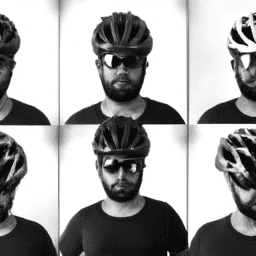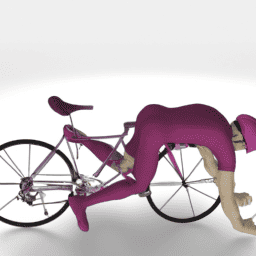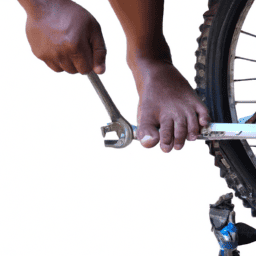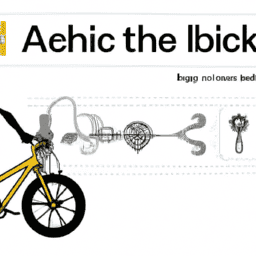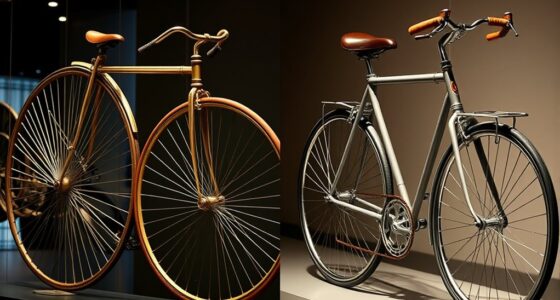As someone who rides bikes, I understand how crucial it is to wear the right bike helmet. It goes beyond merely trying to appear stylish or adhering to legal requirements; it’s fundamentally about safeguarding your head against potentially life-threatening injuries.
Choosing the right helmet can be overwhelming, with so many options available on the market. However, with a little bit of knowledge and research, you can find the perfect helmet that fits your head and meets safety standards.
The first step in choosing a bicycle helmet is measuring your head to find the right fit. This is crucial because a helmet that doesn’t fit properly won’t protect you optimally. You can measure your head by using a soft tape measure and wrapping it around your head, just above your eyebrows and ears. Make sure the tape measure is snug but not too tight.
Once you have your measurement, check the helmet’s sizing chart to find the appropriate size for your head. Remember, different brands and models may have slightly different sizing, so always check before purchasing.
Key Takeaways
- Safety should always be the top priority when choosing a helmet, so look for helmets that meet safety standards like CPSC and EN1078.
- Trying on different helmets is necessary to find the perfect fit, so narrow down options to helmets that meet safety standards and try on a variety of helmets to find the perfect fit.
- Factors to consider when choosing a specific type of helmet, such as road cycling or mountain biking, include ventilation, aerodynamics, type of trails, riding technique, and full-face coverage.
- Personal style and brand reputation can be important factors for some riders, but the most important factor is finding a helmet that fits well and feels comfortable on your head.
Measure Your Head to Find the Right Fit
To get the perfect fit for your noggin, you’ll wanna measure it up with a soft tape measure like a tailor uses, making sure it’s snug but not too tight.
Measuring techniques may vary, but the most common method is to wrap the tape measure around the widest part of your head, just above your eyebrows and ears. Take note of the measurement in centimeters or inches, and check the helmet manufacturer’s sizing chart to choose the appropriate size.
Common mistakes when measuring for a helmet include using a metal tape measure, which can be too stiff and provide an inaccurate reading, and measuring over hair or hats, which can add extra bulk and result in a loose fit.
Once you have your helmet, adjust the straps so that they sit comfortably just below your chin, with no slack or tightness.
Now that you’ve got the right fit, let’s consider the type of riding you’ll be doing.
Consider the Type of Riding You’ll Be Doing
When considering the type of riding I’ll be doing, there are three primary categories that come to mind: road cycling, mountain biking, and commuting.
For road cycling, the focus is on speed and efficiency, so a helmet that’s lightweight and aerodynamic is ideal.
On the other hand, for mountain biking, a helmet with more coverage and protection is necessary due to the potential for more intense impacts.
Finally, for commuting, a helmet with a visor and reflective elements can help improve visibility and safety during urban riding.
Road Cycling
As I hit the road on my bike, I always make sure to choose a helmet that fits snugly and securely on my head for maximum protection.
When it comes to road cycling helmets, there are a few factors to consider in order to choose the right one. Firstly, consider the ventilation of the helmet. Road cycling can be a sweaty sport, so make sure the helmet has adequate ventilation to keep your head cool and comfortable.
Secondly, look for a helmet that is aerodynamic to reduce wind resistance and improve your speed.
And finally, choose a helmet with a visor or brim to protect your eyes from the sun and any debris that may fly up while riding.
Once you have chosen the right helmet, it is important to properly adjust it for the best fit. Start by adjusting the straps so that they form a V-shape under each ear and fasten the chin strap securely. The helmet should fit snugly on your head, but not be too tight or uncomfortable. If the helmet has a dial or ratchet system, adjust it until it fits securely.
Remember to always wear your helmet whenever you go for a ride, and replace it if it is ever involved in a crash.
Now, let’s move on to the next subtopic about mountain biking.
Mountain Biking
Get ready to hit the trails on your mountain bike! Make sure you have the right gear to stay safe and comfortable while riding. When it comes to mountain biking, a helmet is a crucial piece of equipment. It protects your head from potential impact and ensures that you can continue to ride safely. But with so many different helmets on the market, how do you choose the right one for you?
One important factor to consider is the type of trails you’ll be riding on. Different trails require different levels of protection, so make sure to choose a helmet that is appropriate for the type of riding you plan to do. Additionally, consider your riding technique – if you like to take risks and push yourself to the limit, you may want a helmet with extra features such as a visor or extended coverage. To help you make a decision, check out the table below which outlines different helmet features and their benefits for mountain biking.
| Feature | Benefit |
|---|---|
| Full-Face Coverage | Maximum protection for downhill or aggressive riding |
| MIPS Technology | Reduces rotational forces in the event of an impact |
| Ventilation | Keeps your head cool during hot rides |
| Visor | Provides shade and protection from the sun |
| Adjustable Fit | Ensures a comfortable and secure fit for any head shape |
As you can see, there are many different factors to consider when choosing a mountain biking helmet. But with the right information, you can make an informed decision and stay safe on the trails. Now, let’s move on to the next section about commuting and how to choose the right helmet for urban riding.
Commuting
Ready to hit the city streets on your bike? As someone who commutes by bicycle every day, I can attest to the many pros and cons of this mode of transportation.
On the one hand, cycling is a great way to stay active, reduce your carbon footprint, and save money on gas and parking. On the other hand, it can be dangerous, especially if you’re sharing the road with cars, buses, and trucks.
That’s why choosing the right bike for commuting is crucial, and so is investing in a high-quality helmet. When it comes to selecting a bike for commuting, you’ll want to consider factors such as comfort, durability, and versatility.
A hybrid or commuter bike with flat handlebars and a lightweight frame is ideal for city riding, as it allows you to sit upright and maneuver through traffic easily. Look for features like fenders, racks, and lights to make your commute more practical and safe. And of course, don’t forget to invest in a good lock to prevent theft.
As for helmets, there are plenty of stylish and functional options on the market. Look for ones that fit snugly, have plenty of ventilation, and meet safety standards set by organizations like the Consumer Product Safety Commission.
With the right gear, you can enjoy a stress-free and safe commute every day. As you consider your options for a bike and helmet, it’s important to look for specific features that will make your ride more comfortable and enjoyable. In the next section, we’ll explore some of the top features to look for in a helmet, so you can find the perfect one to suit your needs.
Look for Specific Features
When choosing your bicycle helmet, don’t forget to prioritize specific features that will suit your needs and preferences.
Here are four items to consider when looking for a helmet:
-
Ventilation: If you plan on riding in hot weather or for long distances, a helmet with good ventilation will help keep you cool and comfortable.
-
Fit system: A good fit system will ensure that your helmet stays securely on your head and provides the best protection in case of impact. Look for helmets with adjustable straps and an adjustable fit system.
-
Visor: If you plan on riding in bright sunlight, a visor can help keep the sun out of your eyes and improve visibility.
-
Style: Design aesthetics and brand reputation can be important factors for some riders. Choose a helmet that not only meets your functional needs but also matches your personal style.
It’s important to remember that while specific features are important, safety should always be your top priority. Make sure to choose a helmet that meets safety standards, such as those set by the Consumer Product Safety Commission (CPSC), and that fits properly to provide the best possible protection in the event of a crash.
Choose a Helmet that Meets Safety Standards
Ensuring your head is protected is crucial, so it’s essential to opt for a helmet that meets safety standards to safeguard yourself from potential accidents. When choosing a helmet, it’s important to consider the materials used and the impact resistance it offers.
Look for helmets that are made from high-quality materials such as polycarbonate, which is known for its durability and toughness. Additionally, helmets that feature multi-density foam can help absorb impacts and provide better protection.
Another factor to consider when choosing a helmet that meets safety standards is its impact resistance. Helmets that have passed safety standards tests such as the Consumer Product Safety Commission (CPSC) or European Safety Standard (EN1078) are a good option. These tests check the helmet’s ability to absorb impact and protect the wearer’s head in different scenarios.
By choosing a helmet that meets these standards, you can be confident that you are getting a quality product that will protect you in the event of an accident. When choosing a helmet that meets safety standards, it’s important to keep in mind the materials used and impact resistance.
Once you’ve narrowed down your options to helmets that meet these standards, the next step is to try them on and choose the one that fits best.
Try on Different Helmets and Choose the One that Fits Best
To find the perfect fit for you, try on a variety of helmets and see which one feels most comfortable and secure. Comfort level is crucial when it comes to choosing a helmet because you want to make sure you can wear it for extended periods without feeling any discomfort or pain.
When trying on different helmets, make sure to adjust the straps and pads according to your head size and shape. A helmet that fits snugly but not too tight is ideal.
Brand preferences can also come into play when choosing a helmet. Some people prefer to stick to a particular brand because they trust its quality and safety standards. However, it’s important to keep an open mind and try on helmets from different brands as well. You may find that a different brand offers a better fit and more comfort than your usual choice.
Ultimately, the most important factor is finding a helmet that fits well and feels comfortable on your head.
Frequently Asked Questions
What materials are bicycle helmets made of and which ones offer the best protection?
When it comes to helmet materials, polycarbonate and expanded polystyrene (EPS) foam are commonly used for their impact resistance. However, MIPS (Multi-directional Impact Protection System) helmets offer the best protection, reducing rotational forces by up to 40%.
Can I reuse a helmet that has been involved in a previous crash?
I wouldn’t recommend reusing a helmet that’s been involved in a previous crash. It may have sustained damage that isn’t visible, compromising its ability to protect your head. Helmet safety is crucial for accident prevention.
Are there any helmets specifically designed for women or children?
Looking for a helmet designed specifically for women or children? There are many options available. Women’s helmet styles vary in color and design, while child helmet size guides ensure a proper fit for safety.
How often should I replace my helmet and what are the signs of wear and tear to look out for?
I replace my helmet every 3-5 years, or sooner if it’s been in a crash or shows signs of wear and tear such as cracks, dents, or loose straps. Regular inspections can help detect these issues.
What is the difference between a MIPS helmet and a non-MIPS helmet and is it worth the extra cost?
When choosing a helmet, consider MIPS (Multi-directional Impact Protection System) vs. traditional helmets. MIPS offers added protection from rotational forces. Fit is crucial, so ensure it’s snug without being uncomfortable. It’s worth the extra cost for your safety.
Conclusion
Well, I hope you found this article helpful in choosing the right bicycle helmet for you. As someone who’s been an avid cyclist for many years, I can’t stress enough how important it is to wear a helmet every time you ride.
Even if you’re just going for a short ride around the block, accidents can happen, and it’s better to be safe than sorry. Coincidentally, just last week, I was out on a ride when a car pulled out in front of me, and I had to swerve to avoid it. Unfortunately, I ended up hitting a pothole and taking a spill.
Thanks to my helmet, I only ended up with a few scrapes and bruises instead of a serious head injury. It really drove home the importance of wearing a good quality helmet that fits properly. Don’t take any chances when it comes to your safety – choose a helmet that meets safety standards and fits you well.
